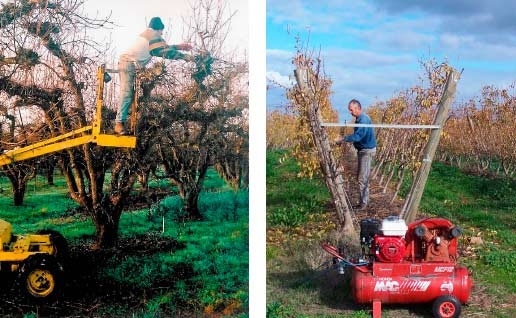Systems research: No single researcher could cover this whole field since a wide range of expertise was needed, as well as the great amount of work involved
We became a scientific multi-disciplinary team. We emphasised basic research, which we then applied to the orchard.
(cont from last month)
We developed a blue-print for an orchard system that integrated all the horticultural factors involved in establishing and maintaining a planting of fruit trees. This team approach became known as Systems Research.
We not only had to thoroughly understand the basic science concerned, we also had to work with orchardists who tried the Tatura orchard system on a commercial scale, convincing the orchardists that the technologies and the science behind them, were sound and adaptable.
Building on success
The old Horticultural Research Station set up its first experimental plantings of canning peaches, pears and apricots in 1937 on its 40 hectare irrigation property.
From then on, the researchers solved orchardists’ problems and recommended the best:
fertilisers
soil management
irrigation method and timing
drainage
salinity control
land-use capability
crop loading
close-planting
control of tree growth without rootstocks
propagate fruit trees from cuttings
pruning and thinning
growth regulators and ripening
tree propagation
harvest
mechanisation
new peach varieties
tree architecture.
Our basic research led to understanding the problem and obtaining the most satisfactory solution to the problem.
Out of these large research programs evolved two unique blue-prints for orchardists to follow: the Tatura Trellis and the Tatura Soil Management.
The Tatura Trellis & Tatura Soil Management
The Tatura Trellis and Tatura Soil Management marked the culmination of a great deal of research on the fruit tree and the soil.
In developing these systems, we analysed the conventional free-standing orchard tree and its soils, and synthesised this information into two new joint systems for growing fruit trees under intensive management, to give early cropping, high yields per hectare, ease of management, be compatible with existing orchard equipment, and the prospect of mechanising summer pruning and harvesting the fruit.
The blue-print of the new modern orchard also had to be aligned with technologies to reduce labour costs and improve fruit quality and pack-outs.
To ensure quick adoption of the Tatura Trellis, tree architecture was already suited to the existing orchard equipment, so orchardists did not have to change and invest in new expensive orchard equipment.
The Tatura Trellis also had to be adaptable to a wide range of temperate fruit crops, nuts, grapevines and kiwifruit, and fit existing row spacings (e.g. 5.5 m).
The success of the Tatura Trellis started with soil preparation before trees were planted, installing a low-flow irrigation system (drip or micro-jet), erecting the trellis, planting and managing the trees and all operations through to hand or mechanical harvesting.
Apply research findings to commercial orchard conditions
To encourage commercial adoption of the Tatura Trellis as a fully integrated system of orchard management, we did the following:
Scientific papers published in international horticulture and soil science journals, and conference presentations, were re-written for grower magazines, chapters in books, Technotes, DAV Research Reports and newspaper articles.
A series of Departmental Agnotes were written by each researcher their own field, as guides for those who wanted to adopt the Tatura system of growing fruit.
The Agnotes were part of a large extension model to reach orchardists, farmers and nurserymen.
Field days, open days and demonstrations were organised to show the intricacies of the Tatura system of growing fruit.
Even classes of school children were shown around different experiments and the mechanical harvester and hedger.
(cont next month)
See this article in Tree Fruit Sept 2019






















